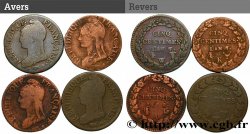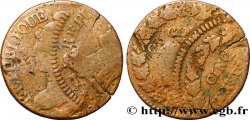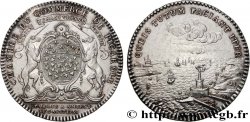fme_741933 - DIRETTORIO Médaille, Conseil des Cinq-Cents
non disponibile.
Articolo venduto sul nostro negozio (2023)
Prezzo : 200.00 €
Articolo venduto sul nostro negozio (2023)
Prezzo : 200.00 €
Tipo : Médaille, Conseil des Cinq-Cents
Data: 1798
Metallo : stagno
Diametro : 49,5 mm
Asse di coniazione : 12 h.
Peso : 49,02 g.
Orlo : lisse
Marchio : sans poinçon
Commenti sullo stato di conservazione:
Usure régulière sur les reliefs. Présence de coups sur la tranche, notamment à 6 heures au revers
Diritto
Titolatura diritto : RÉPUBLIQUE - FRANÇAISE / REPRÉS. DU PEUP. / L’AN VI..
Descrittivo diritto : Faisceau coiffé d’un bonnet phrygien, accosté de branches de laurier et de chêne, cornes d’abondance au pied du faisceau, le tout dans une couronne de chêne; à l’exergue : REPRES. DU PEUP / L’AN VI..
Rovescio
Titolatura rovescio : CONSEIL DES CINQ-CENTS // CONSTITUTION / DE / L'AN TROIS.
Descrittivo rovescio : Ourobouros entourant les tables de lois posée sur un niveau. Nom du récipiendaire à l’exergue.
Commento
Le Conseil des Cinq-Cents, “chambre basse”, était l'une des deux Assemblées du Directoire. Composé de 500 députés comme son nom l'indique, le Conseil était élu au suffrage censitaire à deux tours, conformément à la Constitution de l'An III, chacun devait être âgé de plus de 30 ans et résidant depuis au moins dix ans sur le territoire national. Les citoyens de chaque canton, hommes majeurs de vingt et un ans, payant une contribution directe ou justifiant de services militaires actifs dans l'armée et résidant en France depuis au moins un an, se réunissaient en assemblées primaires afin de désigner un « grand électeur » pour 200 habitants. Le Conseil avait l'initiative des projets de Loi soumis ensuite au Conseil des Anciens, “chambre haute”. Ses députés dressaient la liste où le Conseil des Anciens devait choisir les Directeurs. Après les élections de l'An V, la majorité thermidorienne disparut. L'Assemblée fut renversée et dissoute par le Coup d'État de Bonaparte le 18 brumaire An 8 (9 novembre 1799).
The Council of Five Hundred, the “lower house,” was one of the two Assemblies of the Directory. Composed of 500 deputies, as its name suggests, the Council was elected by two-round suffrage, in accordance with the Constitution of the Year III. Each had to be over 30 years old and have resided in the national territory for at least ten years. The citizens of each canton, men over the age of twenty-one, paying a direct tax or having active military service in the army and residing in France for at least one year, met in primary assemblies to appoint a “great elector” for every 200 inhabitants. The Council had the initiative for draft laws, which were then submitted to the Council of Elders, the “upper house.” Its deputies drew up the list from which the Council of Elders would choose the Directors. After the elections of the Year V, the Thermidorian majority disappeared. The Assembly was overthrown and dissolved by Bonaparte's coup d'état on 18 Brumaire Year 8 (November 9, 1799)
The Council of Five Hundred, the “lower house,” was one of the two Assemblies of the Directory. Composed of 500 deputies, as its name suggests, the Council was elected by two-round suffrage, in accordance with the Constitution of the Year III. Each had to be over 30 years old and have resided in the national territory for at least ten years. The citizens of each canton, men over the age of twenty-one, paying a direct tax or having active military service in the army and residing in France for at least one year, met in primary assemblies to appoint a “great elector” for every 200 inhabitants. The Council had the initiative for draft laws, which were then submitted to the Council of Elders, the “upper house.” Its deputies drew up the list from which the Council of Elders would choose the Directors. After the elections of the Year V, the Thermidorian majority disappeared. The Assembly was overthrown and dissolved by Bonaparte's coup d'état on 18 Brumaire Year 8 (November 9, 1799)








 Segnalare un errore
Segnalare un errore Stampate la pagina
Stampate la pagina Condividi mia selezione
Condividi mia selezione Fai una domanda
Fai una domanda Consegnare / vendere
Consegnare / vendere
 Descrittivo
Descrittivo












